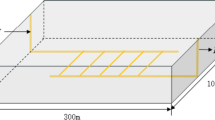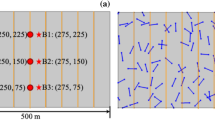Abstract
With a previously developed numerical model, we perform a detailed study of the heat extraction process in enhanced or engineered geothermal system (EGS). This model takes the EGS subsurface heat reservoir as an equivalent porous medium while it considers local thermal non-equilibrium between the rock matrix and the fluid flowing in the fractured rock mass. The application of local thermal non-equilibrium model highlights the temperature-difference heat exchange process occurring in EGS reservoirs, enabling a better understanding of the involved heat extraction process. The simulation results unravel the mechanism of preferential flow or short-circuit flow forming in homogeneously fractured reservoirs of different permeability values. EGS performance, e.g. production temperature and lifetime, is found to be tightly related to the flow pattern in the reservoir. Thermal compensation from rocks surrounding the reservoir contributes little heat to the heat transmission fluid if the operation time of an EGS is shorter than 15 years. We find as well the local thermal equilibrium model generally overestimates EGS performance and for an EGS with better heat exchange conditions in the heat reservoir, the heat extraction process acts more like the local thermal equilibrium process.











Similar content being viewed by others
Abbreviations
- a :
-
Specific surface area of aperture network, 1/m
- c p :
-
Heat capacity, J/(kg K)
- g :
-
Acceleration of gravity, m/s2
- h :
-
Convective heat transfer coefficient, W/(m2 K)
- k :
-
Thermal conductivity, W/(m K)
- k eff s :
-
Thermal conductivity of rock, W/(m K)
- k eff l :
-
Thermal conductivity of heat transmission fluid, W/(m K)
- K :
-
Permeability, m2
- P :
-
Pressure, Pa
- t :
-
Time, s
- T :
-
Temperature, K
- T f :
-
Liquid temperature, K
- T f,in :
-
Injection temperature, K
- T f,out :
-
Production temperature, K
- T s :
-
Rock temperature, K
- u :
-
Velocity vector, m/s
- x :
-
Horizontal axis in Cartesian coordinates
- y :
-
Vertical axis in Cartesian coordinates
- z :
-
Horizontal axis in Cartesian coordinates
- ρ :
-
Density, kg/m3
- ε :
-
Porosity
- μ :
-
Viscosity, m2/s
- τ :
-
EGS lifetime, years
- γ :
-
Heat extraction ratio
- γ L :
-
Local heat extraction ratio
- eff :
-
Effective
- f :
-
Fluid
- s :
-
Solid or rock
- L :
-
Local
References
World Energy Council (1998) Survey of energy resources. World Energy Council, Houston
Li KW (2013) Comparison of geothermal with solar and wind power generation systems. In: Proceedings of the 38th workshop on geothermal reservoir engineering, Stanford University, Stanford, California
Lacirignola M, Blanc I (2013) Environmental analysis of practical design options for enhanced geothermal systems (EGS) through life-cycle assessment. Renew Energy 50:901–914
Tester JW, Anderson BJ, Batchelor AS, Blackwell DD, DiPippo R, Drake EM et al (2006)The future of geothermal energy, Impact of Enhanced Geothermal Systems (EGS) on the United States in the 21st Century. Assessment by an MIT-led interdisciplinary panel (Tester JW, Chairman)
Bertani R (2012) Geothermal power generation in the world 2005–2010 update report. Geothermics 41:1–29
Genter A, Evans K, Cuenot N, Fritsch D, Sanjuan B (2010) Contribution of the exploration of deep crystalline fractured reservoir of Soultz to the knowledge of enhanced geothermal systems (EGS). C R Geosci 342:502–516
Tenma N, Yamaguchi T, Zyvoloski G (2008) The Hijiori hot dry rock test site, Japan: evaluation and optimization of heat extraction from a two-layered reservoir. Geothermics 37:19–52
Parker R (1999) The Rosemanowes HDR project 1983–1991. Geothermics 28:603–615
Wan Z, Zhao Y, Kang J (2005) Forecast and evaluation of hot dry rock geothermal resource in China. Renew Energy 30:1831–1846
U.S. Department of Energy. First commercial success for enhanced geothermal systems spells exponential growth for the future of geothermal energy. see: http://www1.eere.energy.gov/geothermal/news_detail.html?news_id=19234
Bataillé A, Genthon P, Rabinowicz M, Fritz B (2006) Modeling the coupling between free and forced convection in a vertical permeable slot: implications for the heat production of an Enhanced Geothermal System. Geothermics 35:654–682
Taron J, Elsworth D (2009) Thermal–hydrologic–mechanical–chemical processes in the evolution of engineered geothermal reservoirs. Int J Rock Mech Min 46:855–864
Xu T, Sonnenthal E, Spycher N, Pruess K (2006) TOUGHREACT—a simulation program for non-isothermal multiphase reactive geochemical transport in variably saturated geologic media: applications to geothermal injectivity and CO2 geological sequestration. Comput Geosci 46:145–165
Gelet R, Loret B, Khalili N (2012) A thermo-hydro-mechanical coupled model in local thermal non-equilibrium for fractured HDR reservoir with double porosity. J Geophys Res 117:B07205–B07228
Shaik AR, Rahman SS, Tran NH, Tran T (2011) Numerical simulation of fluid-rock coupling heat transfer in naturally fractured geothermal system. Appl Therm Eng 31:1600–1606
Wu YS, Liu HH, Bodvarsson GS (2004) A triple-continuum approach for modeling flow and transport processes in fractured rock. J Contam Hydrol 73:145–179
Jiang FM, Luo L, Chen JL (2013) A novel three-dimensional transient model for subsurface heat exchange in enhanced geothermal systems. Int Commun Heat Mass 41:57–62
Jiang FM, Chen JL, Huang WB, Luo L (2014) A three-dimensional transient model for EGS subsurface thermo-hydraulic process. Energy 72:300–310
U.S. Department of Energy (2008) An evaluation of Enhanced Geothermal Systems technology. https://www1.eere.energy.gov/geothermal/pdfs/evaluation_egs_tech_2008.pdf
Popiel CO, Wojtkowiak J, Biernacka B (2001) Measurements of temperature distribution in ground. Exp Therm Fluid Sci 25:301–309
Vogt C, Kosack C, Marquart G (2012) Stochastic inversion of the tracer experiment of the enhanced geothermal system demonstration reservoir in Soultz-sous-Forêts —Revealing pathways and estimating permeability distribution. Geothermics 42:1–12
Karrech A (2013) Non-equilibrium thermodynamics for fully coupled thermal hydraulic mechanical chemical processes. J Mech Phys Solids 61:819–837
Radilla G, Sausse J, Sanjuan B, Fourar M (2012) Interpreting tracer tests in the enhanced geothermal system (EGS) of Soultz-sous-Forêts using the equivalent stratified medium approach. Geothermics 44:43–51
Crandall D, Siriwardane H, Bromhal G (2011) Modeling fluids and fractures in geothermal systems. In: Proceedings of the ASME 2011 5th international conference on energy sustainability, Washington, DC
Finsterle S, Zhang Y, Pan L, Dobson P, Oglesby K (2013) Microhole arrays for improved heat mining from enhanced geothermal systems. Geothermics 47:104–115
Manga M, Beresnev I, Brodsky EE, Elkhoury JE, Elsworth D, Ingebritsen SE et al (2012) Changes in permeability caused by transient stresses: field observations, experiments, and mechanisms. Rev Geophys 50:1–24
Yari M (2010) Exergetic analysis of various types of geothermal power plants. Renew Energy 35:112–121
Kanoglu M, Bolatturk A (2008) Performance and parametric investigation of a binary geothermal power plant by exergy. Renew Energy 33:2366–2374
Shyy W, Garbey M, Appukuttan A, Wu J (2002) Evaluation of Richardson extrapolation in computational fluid dynamics. Numer Heat Transf Part B Fundam 41(2):139–164
Rybach L, Mongillo M (2006) Geothermal sustainability-a review with identified research needs. GRC Trans 30:1083–1090
Butler SJ, Sanyal SK, Tait AR (2004) A numerical simulation study of the performance of enhanced geothermal systems. In: Proceedings of the 29th workshop on geothermal reservoir engineering, Stanford University, Stanford, California
Breede K, Dzebisashvili K, Liu X, Falcone G (2013) A systematic review of enhanced (or engineered) geothermal systems: past, present and future. Geotherm Energy 1(1):1–27
Pruess K (2008) On production behavior of enhanced geothermal systems with CO2 as working fluid. Energy Convers Manag 49:1446–1454
Fox DB, Sutter D, Beckers KF, Lukawski MZ, Koch DL, Anderson BJ, Tester JW (2013) Sustainable heat farming: modeling extraction and recovery in discretely fractured geothermal reservoirs. Geothermics 46:42–54
Acknowledgments
Financial support received from the China National “863” Project (2012AA052802), the China National Science Foundation and Guangdong-Province Joint Project (U1401232), the Key Scientific Development Project of Guangdong Province (2014A030308001), the CAS “100 talents” Program (FJ), and the China National Science Foundation (51406213, 51206174) is gratefully acknowledged.
Author information
Authors and Affiliations
Corresponding author
Rights and permissions
About this article
Cite this article
Chen, J., Jiang, F. A numerical study of EGS heat extraction process based on a thermal non-equilibrium model for heat transfer in subsurface porous heat reservoir. Heat Mass Transfer 52, 255–267 (2016). https://doi.org/10.1007/s00231-015-1554-y
Received:
Accepted:
Published:
Issue Date:
DOI: https://doi.org/10.1007/s00231-015-1554-y




